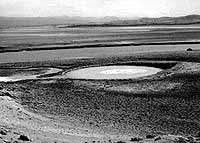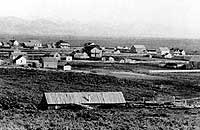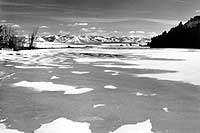|
Page
81
|




|
||
 |
||
| Steamboat Spring, just south of the Cedar View Country Club, west of Soda Springs, October, 1990. This spring, which formerly made a noise like a rushing steamboat engine, is usually covered with the waters of Soda Point Reservoir. The original Morrisite settlement of Soda Springs was north of the Bear River, to the left of this photograph. | ||
 |
||
| North side of the Soda Springs village, north of the railroad tracks, 1890. Photo was taken looking south from the north end of Main St. Johnny Woodale collection, Horsley Municipal Library, Soda Springs. | ||
 |
||
| Soda Point or Alexander Reservoir, covered with ice, (March, 1990). The snow-covered Aspen Range is in the background. | ||
 |
||
| Idan-ha' Hotel in Soda Springs about 1899, looking north across the Oregon Short Line. The luxurious hotel opened August 12, 1887. The elaborate gabled structure, built for railroad visitors to the bubbling springs, was furnished in French Provincial. It burned down June 7, 1921, suffering the same fate as most large frame buildings built in Idaho in the late 1800s. An exploding still (1921 was during Prohibition) was supposedly the cause of the fire. The Caribou Hotel, another old Soda Springs landmark, burned in 1923. Photo from Abe Lillibridge collection, Idaho State University. |
The
Kackley Family
Doctor Ellis
Kackley, fresh out of the University of Tennessee Medical School, came to Soda
Springs in 1898, resolved to become "The Best Damn Doctor in the West".
Many would say he succeeded (carney, 1990). He, his wife, Ida Sarver Kackley,
and son, Evan, served the area for over 50 years, performing feats of frontier
medicine by using ingenuity and common sense. He and Evan built the first Soda
Springs hospital in 1925 to 1927. The hospital doubled in size to 40 beds in
1932. Ellis delivered over 4,000 babies.
Ellis Kackley died in November 1943, when Evan was in the Pacific during World War II. Twenty-five hundred people attended his funeral, which was held in the Soda Springs High School. His two large dogs created a commotion at the wake. Evan said his father would have enjoyed knowing that the dogs were still in control.
Butch
Cassidy's Gang
Butch Cassidy
and his band of outlaws frequented the Soda Springs area in the late 1890s,
and had a camp in Star Valley, Wyoming. They, like some Mormon polygamists,
found refuge in this isolated valley. Cassidy's gang robbed the Montpelier Bank
of $16,500 on August 13, 1896, and escaped up Montpelier Canyon. An unmounted
pack horse carried the loot out from under the nose of the posse.
On June 2, 1899, Cassidy's Gang robbed the Overland Flyer of the Union Pacific Railroad. Later that summer Dr. Kackley was asked to treat a wounded member of the gang that was holed up near Freedom, Wyoming. Both Kackley and Cassidy sympathized with underdogs and did not like the big corporations. Kackley brought the injured man to Soda Springs under cover of darkness and housed him close to the railroad. Another of the Cassidy Gang was disguised as a woman and took care of the injured man until he recovered.
Geology
of the Soda Springs Area
Soda Springs is
located near the trace of the Paris thrust fault, which separates the older,
Late Proterozoic and Lower Paleozoic rocks of the Bear River Range from the
younger Paleozoic rocks of the Preuss Range north and east of town. These younger
rocks, belonging to the Meade thrust plate, contain the Permian Phosphoria Formation
which is so important to the economy of the Soda Springs area.
Phosphate
Mining
Phosphate mining
began in the Soda Springs area in 1920 with an underground mine at Conda, named
for the owner, Anaconda Copper Co. The Conda mine and townsite was officially
abandoned on August 31, 1984.
Today the phosphate industry is the largest employer in the Soda Springs area, with several open-pit mines north and east of Soda Springs and large chemical processing plants on the north edge of town.
Reserves are large and demand is constant. Unlike the silver mining business, phosphate mining will be a strong industry for the foreseeable future. According to the Idaho Geological Survey, in 1990, Idaho's annual revenue from phosphate mining and processing was nearly $600 million. Silver mining produced about $70 million.
Anyone who has traveled U.S. Highway 30 through Soda Springs on a cloudy night will remember the ghostly red glow reflected off the bottoms of low clouds hanging above the molten slag piles near the Monsanto Chemical Plant north of the city.